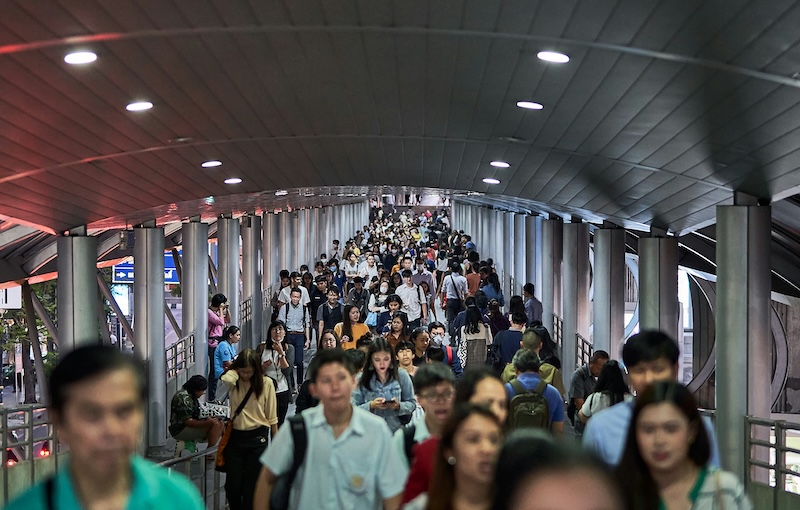Get your head out of the cloud

Another day, another CEO decides there aren’t enough people around any more, and therefore it’s time for a “return to office” mandate, known to its few friends and many enemies as RtO.
Today, it’s Amazon CEO Andy Jassy’s turn. After all, how can a cloud company possibly operate without everyone being on premises at all times? It’s almost like that dynamic agile work-from-anywhere message is only for the marketing slides…
These RtO moves are well understood by all concerned to constitute “quiet firing”, instigating “voluntary attrition” among employees, also known as a “Stealth RiF”, which stands for “reduction in force” — so many euphemisms for just getting rid of people. Translated, the meaning is simply that people would rather quit than commute to work. To be clear, this is absolutely the correct response: commuting is hell, and it’s time and money taken directly from employees’ pockets. It also makes everyone else’s life worse, snarling up the traffic around Amazon offices.

Too Many Chiefs?
The Amazon situation also includes this little nugget:
we’re asking each s-team organization to increase the ratio of individual contributors to managers by at least 15% by the end of Q1 2025.
What this proviso means is that the aforementioned reduction will be made up in significant part by departures of managers and senior employees who no longer have promotion prospects at Amazon.
Some will say that Amazon needs to get back to a flatter organizational structure, but those are not without their own downsides. Notably, if your manager now has 15% more direct reports, you have correspondingly less face-time and mind-share with them. Andy Jassy claims that the proliferation of layers of management has had bad effects:
pre-meetings for the pre-meetings for the decision meetings, a longer line of managers feeling like they need to review a topic before it moves forward, owners of initiatives feeling less like they should make recommendations because the decision will be made elsewhere, etc.
Now instead there will indeed be fewer layers of management — but the managers at each layer will have less time to consider the decisions they are being asked to make. Not sure that’s a win.
One of the big exports of Amazon’s management culture is the famous “six-pager”. This is the (roughly) six-page document that everyone is supposed to read before a decision meeting. The doc lays out what is being proposed, any relevant background, potential outcomes under different scenarios, and so on. Writing these documents properly takes time and effort; trust me, I’ve done it. Done right, the memos are also very information-dense, so reading them and absorbing their contents also takes time; they can’t simply be skimmed. They also tend to provoke questions and discussion.
Maybe Amazon had too many layers of management around the place, gumming up the works — or maybe what will happen is that the managers will have less time to absorb the pre-meeting information. The result in that case will be even more need for “pre-meetings for the pre-meetings for the decision meetings”.

The Mythical Person-Month
This whole thing reeks of Mythical Man-Month thinking : if being in the office sometimes is great, being in the office always must be even better! Except in this instance, the justification for the RtO mandate is not the usual claim that being in the office will lead to more innovation or collaboration or productivity. Instead, Bezos simply claims that everyone being in the office will somehow strengthen the Amazon culture.
But it gets better!
We are also going to bring back assigned desk arrangements in locations that were previously organized that way, including the U.S. headquarters locations (Puget Sound and Arlington). For locations that had agile desk arrangements before the pandemic, including much of Europe, we will continue to operate that way.
So… how do I actually find my team-mates that I need to work with today, since we are all scattered around the office wherever we could find a perch? Oh yeah, we all get on Chime (not Zoom or Teams, oh no, this is Amazon after all) and meet there. What part of that could not have been accomplished from my home office? And let’s not even talk about the disreputable scramble and inevitable office vendettas that will result as everyone tries to nab the good desks with some hope of natural light, livable temperatures, and minimum chance of interruption.
The Filling of the Sandwich
It’s perhaps symptomatic that this memo forces its readers to wade through 700 words of nonsense and personal anecdote before the key information that they have all been dreading since they saw it pop up in their inbox.
Look, I’m not a work-from-home absolutist; check out the WfH tag right here on this very blog for examples. Working in isolation exclusively doesn’t work for anyone (not even for me). But for the same reason, forcing everyone into the office isn’t going to have universally good outcomes either.
Amazon is big enough that this is hardly going to sink the company, but it is going to have consequences at the margins. Look for lots more somewhat-senior ex-Amazon people to be starting new roles over the next six months — coincidentally, all remote.
🖼️ Andy Jassy image from About Amazon site, other photos by Robert Bye and Norbert Braun on Unsplash